Review of Hill's 'Paul and the Trinity': Trinitarian Theology and Paul
VerifiedAdded on 2022/12/30
|7
|1531
|31
Report
AI Summary
This report is a comprehensive book review of Wesley Hill's 'Paul and the Trinity: Persons, Relations, and the Pauline Letters.' It examines Hill's argument that Pauline texts reveal a mutual recognition of God, Jesus, and the Holy Spirit, advocating for a 'horizontal axis' approach to understanding their relationships, challenging the traditional 'vertical axis' perspective. The review highlights Hill's use of biblical Greek and his exploration of the interplay between exegesis and Trinitarian theology. Positive aspects include Hill's attempt to explain complex philosophical concepts and his critical evaluation of the high/low Christology model. The review also discusses Hill's introduction of 'redoublement' as an interpretive tool. Weaknesses are identified in the ambiguity of his alternative model and a lack of visual aids to explain the interconnectedness of the relationships. Overall, the review acknowledges the book's significant contribution to New Testament literature and Trinitarian theologies, emphasizing Hill's passion for unifying biblical exegesis and Trinitarian theology.

1
Book Review
Students Name
Unit Title
Date
Book Review
Students Name
Unit Title
Date
Paraphrase This Document
Need a fresh take? Get an instant paraphrase of this document with our AI Paraphraser
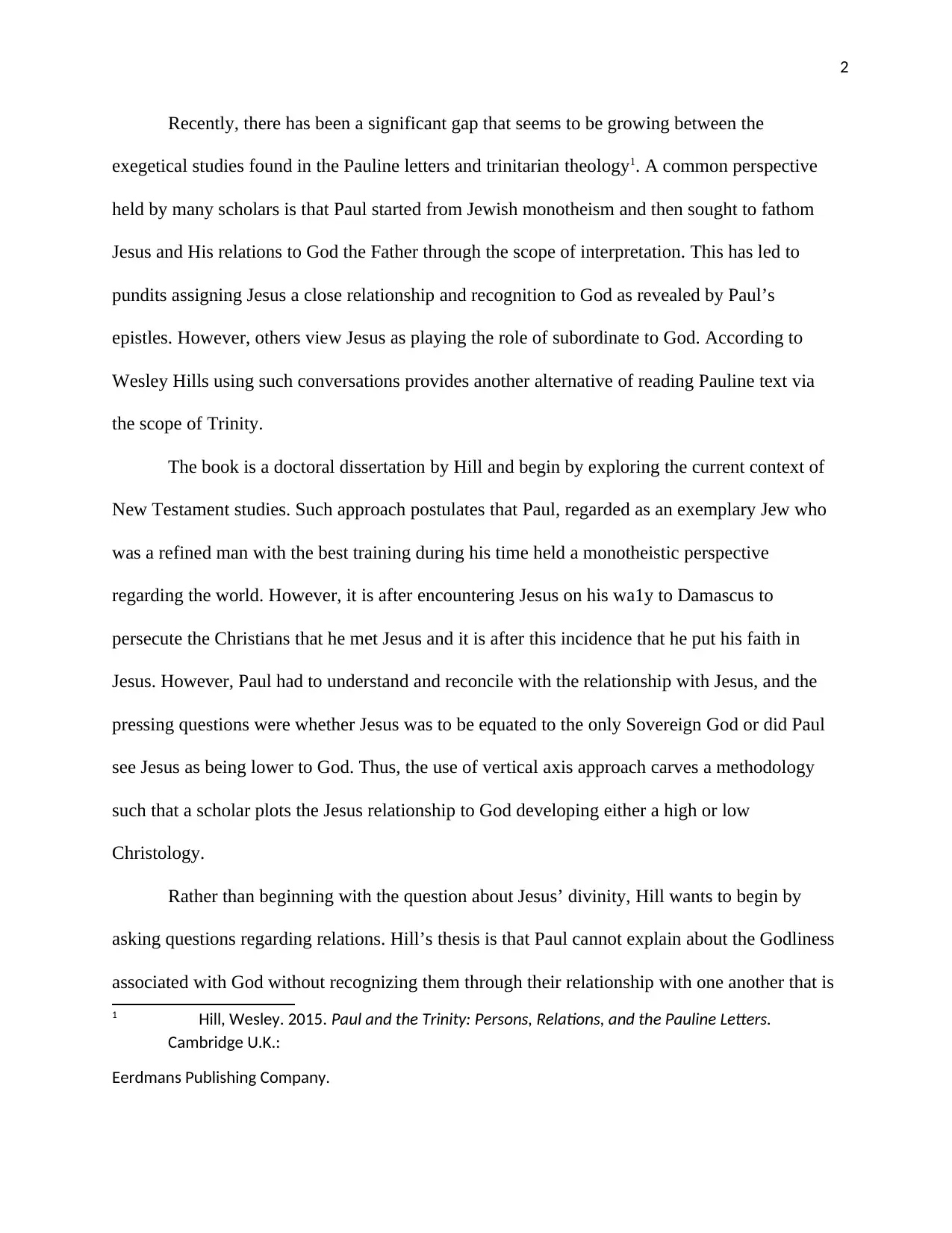
2
Recently, there has been a significant gap that seems to be growing between the
exegetical studies found in the Pauline letters and trinitarian theology1. A common perspective
held by many scholars is that Paul started from Jewish monotheism and then sought to fathom
Jesus and His relations to God the Father through the scope of interpretation. This has led to
pundits assigning Jesus a close relationship and recognition to God as revealed by Paul’s
epistles. However, others view Jesus as playing the role of subordinate to God. According to
Wesley Hills using such conversations provides another alternative of reading Pauline text via
the scope of Trinity.
The book is a doctoral dissertation by Hill and begin by exploring the current context of
New Testament studies. Such approach postulates that Paul, regarded as an exemplary Jew who
was a refined man with the best training during his time held a monotheistic perspective
regarding the world. However, it is after encountering Jesus on his wa1y to Damascus to
persecute the Christians that he met Jesus and it is after this incidence that he put his faith in
Jesus. However, Paul had to understand and reconcile with the relationship with Jesus, and the
pressing questions were whether Jesus was to be equated to the only Sovereign God or did Paul
see Jesus as being lower to God. Thus, the use of vertical axis approach carves a methodology
such that a scholar plots the Jesus relationship to God developing either a high or low
Christology.
Rather than beginning with the question about Jesus’ divinity, Hill wants to begin by
asking questions regarding relations. Hill’s thesis is that Paul cannot explain about the Godliness
associated with God without recognizing them through their relationship with one another that is
1 Hill, Wesley. 2015. Paul and the Trinity: Persons, Relations, and the Pauline Letters.
Cambridge U.K.:
Eerdmans Publishing Company.
Recently, there has been a significant gap that seems to be growing between the
exegetical studies found in the Pauline letters and trinitarian theology1. A common perspective
held by many scholars is that Paul started from Jewish monotheism and then sought to fathom
Jesus and His relations to God the Father through the scope of interpretation. This has led to
pundits assigning Jesus a close relationship and recognition to God as revealed by Paul’s
epistles. However, others view Jesus as playing the role of subordinate to God. According to
Wesley Hills using such conversations provides another alternative of reading Pauline text via
the scope of Trinity.
The book is a doctoral dissertation by Hill and begin by exploring the current context of
New Testament studies. Such approach postulates that Paul, regarded as an exemplary Jew who
was a refined man with the best training during his time held a monotheistic perspective
regarding the world. However, it is after encountering Jesus on his wa1y to Damascus to
persecute the Christians that he met Jesus and it is after this incidence that he put his faith in
Jesus. However, Paul had to understand and reconcile with the relationship with Jesus, and the
pressing questions were whether Jesus was to be equated to the only Sovereign God or did Paul
see Jesus as being lower to God. Thus, the use of vertical axis approach carves a methodology
such that a scholar plots the Jesus relationship to God developing either a high or low
Christology.
Rather than beginning with the question about Jesus’ divinity, Hill wants to begin by
asking questions regarding relations. Hill’s thesis is that Paul cannot explain about the Godliness
associated with God without recognizing them through their relationship with one another that is
1 Hill, Wesley. 2015. Paul and the Trinity: Persons, Relations, and the Pauline Letters.
Cambridge U.K.:
Eerdmans Publishing Company.
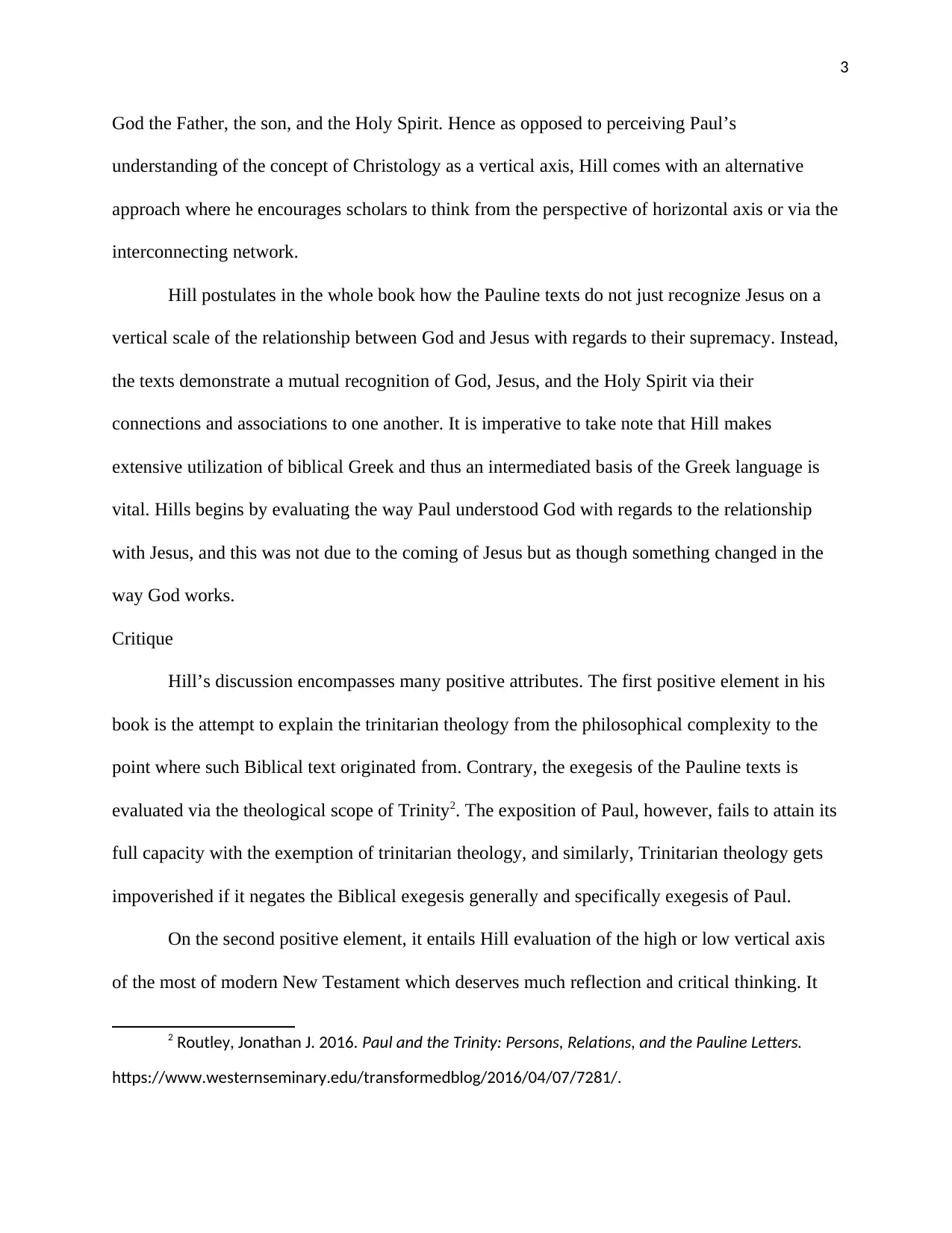
3
God the Father, the son, and the Holy Spirit. Hence as opposed to perceiving Paul’s
understanding of the concept of Christology as a vertical axis, Hill comes with an alternative
approach where he encourages scholars to think from the perspective of horizontal axis or via the
interconnecting network.
Hill postulates in the whole book how the Pauline texts do not just recognize Jesus on a
vertical scale of the relationship between God and Jesus with regards to their supremacy. Instead,
the texts demonstrate a mutual recognition of God, Jesus, and the Holy Spirit via their
connections and associations to one another. It is imperative to take note that Hill makes
extensive utilization of biblical Greek and thus an intermediated basis of the Greek language is
vital. Hills begins by evaluating the way Paul understood God with regards to the relationship
with Jesus, and this was not due to the coming of Jesus but as though something changed in the
way God works.
Critique
Hill’s discussion encompasses many positive attributes. The first positive element in his
book is the attempt to explain the trinitarian theology from the philosophical complexity to the
point where such Biblical text originated from. Contrary, the exegesis of the Pauline texts is
evaluated via the theological scope of Trinity2. The exposition of Paul, however, fails to attain its
full capacity with the exemption of trinitarian theology, and similarly, Trinitarian theology gets
impoverished if it negates the Biblical exegesis generally and specifically exegesis of Paul.
On the second positive element, it entails Hill evaluation of the high or low vertical axis
of the most of modern New Testament which deserves much reflection and critical thinking. It
2 Routley, Jonathan J. 2016. Paul and the Trinity: Persons, Relations, and the Pauline Letters.
https://www.westernseminary.edu/transformedblog/2016/04/07/7281/.
God the Father, the son, and the Holy Spirit. Hence as opposed to perceiving Paul’s
understanding of the concept of Christology as a vertical axis, Hill comes with an alternative
approach where he encourages scholars to think from the perspective of horizontal axis or via the
interconnecting network.
Hill postulates in the whole book how the Pauline texts do not just recognize Jesus on a
vertical scale of the relationship between God and Jesus with regards to their supremacy. Instead,
the texts demonstrate a mutual recognition of God, Jesus, and the Holy Spirit via their
connections and associations to one another. It is imperative to take note that Hill makes
extensive utilization of biblical Greek and thus an intermediated basis of the Greek language is
vital. Hills begins by evaluating the way Paul understood God with regards to the relationship
with Jesus, and this was not due to the coming of Jesus but as though something changed in the
way God works.
Critique
Hill’s discussion encompasses many positive attributes. The first positive element in his
book is the attempt to explain the trinitarian theology from the philosophical complexity to the
point where such Biblical text originated from. Contrary, the exegesis of the Pauline texts is
evaluated via the theological scope of Trinity2. The exposition of Paul, however, fails to attain its
full capacity with the exemption of trinitarian theology, and similarly, Trinitarian theology gets
impoverished if it negates the Biblical exegesis generally and specifically exegesis of Paul.
On the second positive element, it entails Hill evaluation of the high or low vertical axis
of the most of modern New Testament which deserves much reflection and critical thinking. It
2 Routley, Jonathan J. 2016. Paul and the Trinity: Persons, Relations, and the Pauline Letters.
https://www.westernseminary.edu/transformedblog/2016/04/07/7281/.
You're viewing a preview
Unlock full access by subscribing today!
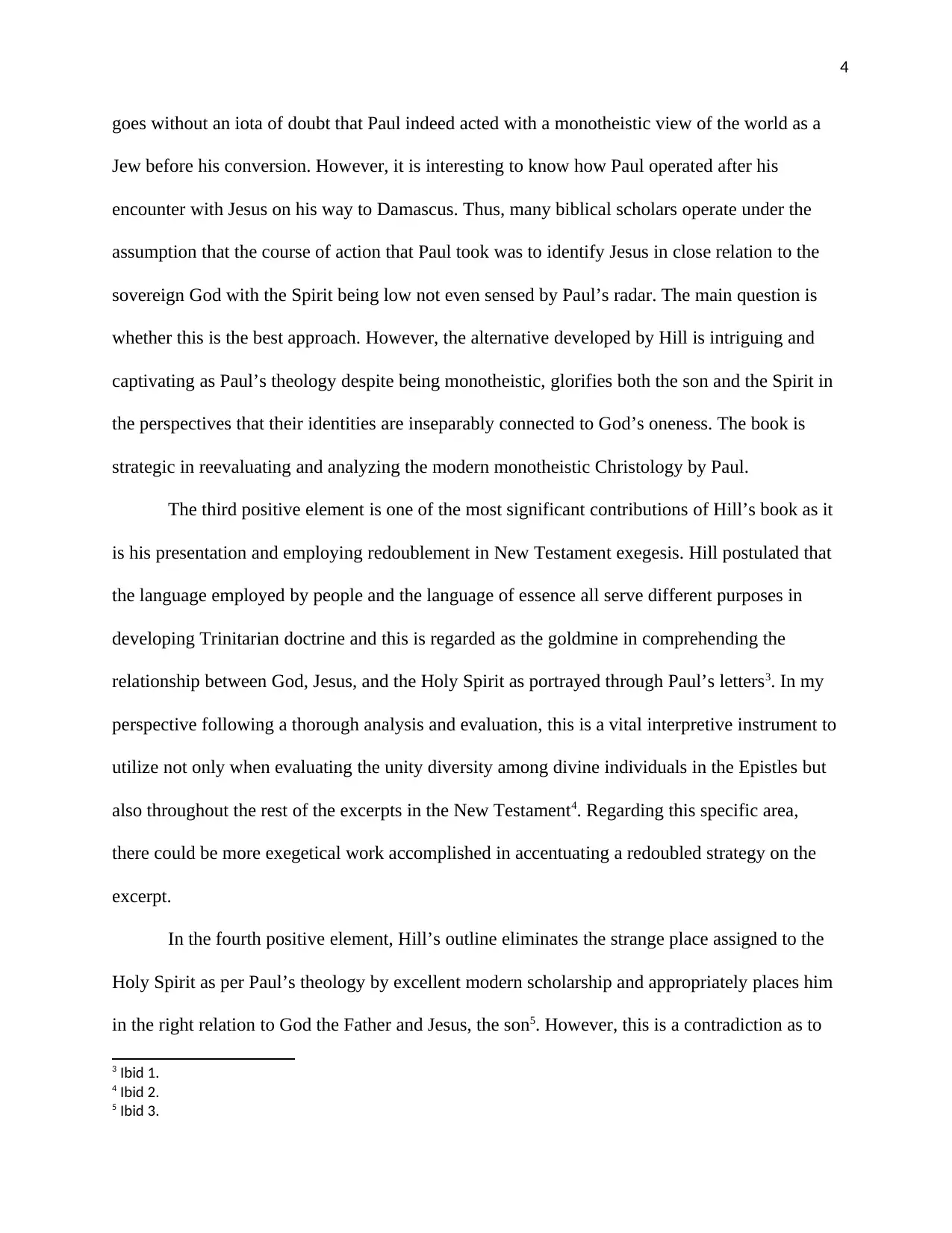
4
goes without an iota of doubt that Paul indeed acted with a monotheistic view of the world as a
Jew before his conversion. However, it is interesting to know how Paul operated after his
encounter with Jesus on his way to Damascus. Thus, many biblical scholars operate under the
assumption that the course of action that Paul took was to identify Jesus in close relation to the
sovereign God with the Spirit being low not even sensed by Paul’s radar. The main question is
whether this is the best approach. However, the alternative developed by Hill is intriguing and
captivating as Paul’s theology despite being monotheistic, glorifies both the son and the Spirit in
the perspectives that their identities are inseparably connected to God’s oneness. The book is
strategic in reevaluating and analyzing the modern monotheistic Christology by Paul.
The third positive element is one of the most significant contributions of Hill’s book as it
is his presentation and employing redoublement in New Testament exegesis. Hill postulated that
the language employed by people and the language of essence all serve different purposes in
developing Trinitarian doctrine and this is regarded as the goldmine in comprehending the
relationship between God, Jesus, and the Holy Spirit as portrayed through Paul’s letters3. In my
perspective following a thorough analysis and evaluation, this is a vital interpretive instrument to
utilize not only when evaluating the unity diversity among divine individuals in the Epistles but
also throughout the rest of the excerpts in the New Testament4. Regarding this specific area,
there could be more exegetical work accomplished in accentuating a redoubled strategy on the
excerpt.
In the fourth positive element, Hill’s outline eliminates the strange place assigned to the
Holy Spirit as per Paul’s theology by excellent modern scholarship and appropriately places him
in the right relation to God the Father and Jesus, the son5. However, this is a contradiction as to
3 Ibid 1.
4 Ibid 2.
5 Ibid 3.
goes without an iota of doubt that Paul indeed acted with a monotheistic view of the world as a
Jew before his conversion. However, it is interesting to know how Paul operated after his
encounter with Jesus on his way to Damascus. Thus, many biblical scholars operate under the
assumption that the course of action that Paul took was to identify Jesus in close relation to the
sovereign God with the Spirit being low not even sensed by Paul’s radar. The main question is
whether this is the best approach. However, the alternative developed by Hill is intriguing and
captivating as Paul’s theology despite being monotheistic, glorifies both the son and the Spirit in
the perspectives that their identities are inseparably connected to God’s oneness. The book is
strategic in reevaluating and analyzing the modern monotheistic Christology by Paul.
The third positive element is one of the most significant contributions of Hill’s book as it
is his presentation and employing redoublement in New Testament exegesis. Hill postulated that
the language employed by people and the language of essence all serve different purposes in
developing Trinitarian doctrine and this is regarded as the goldmine in comprehending the
relationship between God, Jesus, and the Holy Spirit as portrayed through Paul’s letters3. In my
perspective following a thorough analysis and evaluation, this is a vital interpretive instrument to
utilize not only when evaluating the unity diversity among divine individuals in the Epistles but
also throughout the rest of the excerpts in the New Testament4. Regarding this specific area,
there could be more exegetical work accomplished in accentuating a redoubled strategy on the
excerpt.
In the fourth positive element, Hill’s outline eliminates the strange place assigned to the
Holy Spirit as per Paul’s theology by excellent modern scholarship and appropriately places him
in the right relation to God the Father and Jesus, the son5. However, this is a contradiction as to
3 Ibid 1.
4 Ibid 2.
5 Ibid 3.
Paraphrase This Document
Need a fresh take? Get an instant paraphrase of this document with our AI Paraphraser
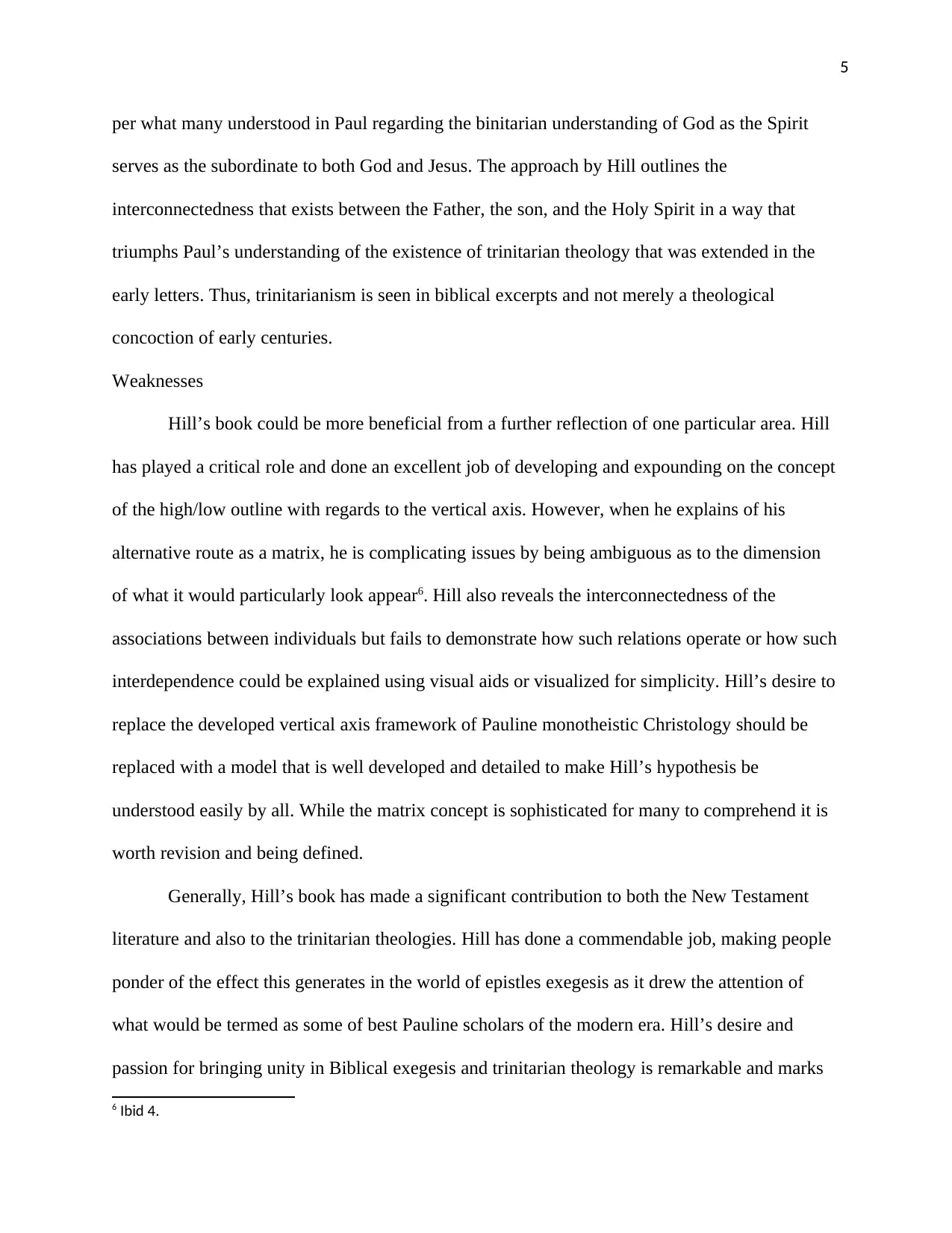
5
per what many understood in Paul regarding the binitarian understanding of God as the Spirit
serves as the subordinate to both God and Jesus. The approach by Hill outlines the
interconnectedness that exists between the Father, the son, and the Holy Spirit in a way that
triumphs Paul’s understanding of the existence of trinitarian theology that was extended in the
early letters. Thus, trinitarianism is seen in biblical excerpts and not merely a theological
concoction of early centuries.
Weaknesses
Hill’s book could be more beneficial from a further reflection of one particular area. Hill
has played a critical role and done an excellent job of developing and expounding on the concept
of the high/low outline with regards to the vertical axis. However, when he explains of his
alternative route as a matrix, he is complicating issues by being ambiguous as to the dimension
of what it would particularly look appear6. Hill also reveals the interconnectedness of the
associations between individuals but fails to demonstrate how such relations operate or how such
interdependence could be explained using visual aids or visualized for simplicity. Hill’s desire to
replace the developed vertical axis framework of Pauline monotheistic Christology should be
replaced with a model that is well developed and detailed to make Hill’s hypothesis be
understood easily by all. While the matrix concept is sophisticated for many to comprehend it is
worth revision and being defined.
Generally, Hill’s book has made a significant contribution to both the New Testament
literature and also to the trinitarian theologies. Hill has done a commendable job, making people
ponder of the effect this generates in the world of epistles exegesis as it drew the attention of
what would be termed as some of best Pauline scholars of the modern era. Hill’s desire and
passion for bringing unity in Biblical exegesis and trinitarian theology is remarkable and marks
6 Ibid 4.
per what many understood in Paul regarding the binitarian understanding of God as the Spirit
serves as the subordinate to both God and Jesus. The approach by Hill outlines the
interconnectedness that exists between the Father, the son, and the Holy Spirit in a way that
triumphs Paul’s understanding of the existence of trinitarian theology that was extended in the
early letters. Thus, trinitarianism is seen in biblical excerpts and not merely a theological
concoction of early centuries.
Weaknesses
Hill’s book could be more beneficial from a further reflection of one particular area. Hill
has played a critical role and done an excellent job of developing and expounding on the concept
of the high/low outline with regards to the vertical axis. However, when he explains of his
alternative route as a matrix, he is complicating issues by being ambiguous as to the dimension
of what it would particularly look appear6. Hill also reveals the interconnectedness of the
associations between individuals but fails to demonstrate how such relations operate or how such
interdependence could be explained using visual aids or visualized for simplicity. Hill’s desire to
replace the developed vertical axis framework of Pauline monotheistic Christology should be
replaced with a model that is well developed and detailed to make Hill’s hypothesis be
understood easily by all. While the matrix concept is sophisticated for many to comprehend it is
worth revision and being defined.
Generally, Hill’s book has made a significant contribution to both the New Testament
literature and also to the trinitarian theologies. Hill has done a commendable job, making people
ponder of the effect this generates in the world of epistles exegesis as it drew the attention of
what would be termed as some of best Pauline scholars of the modern era. Hill’s desire and
passion for bringing unity in Biblical exegesis and trinitarian theology is remarkable and marks
6 Ibid 4.
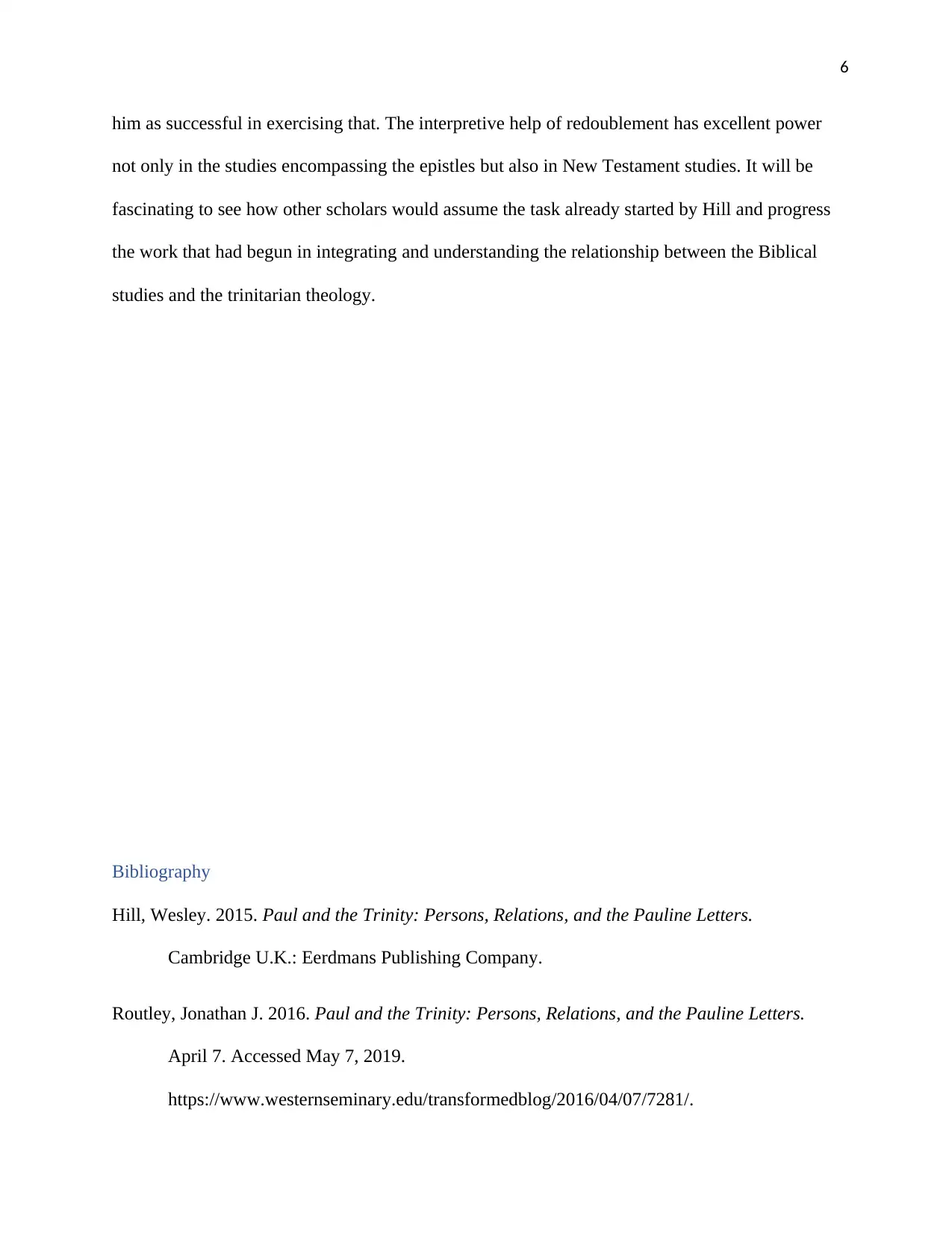
6
him as successful in exercising that. The interpretive help of redoublement has excellent power
not only in the studies encompassing the epistles but also in New Testament studies. It will be
fascinating to see how other scholars would assume the task already started by Hill and progress
the work that had begun in integrating and understanding the relationship between the Biblical
studies and the trinitarian theology.
Bibliography
Hill, Wesley. 2015. Paul and the Trinity: Persons, Relations, and the Pauline Letters.
Cambridge U.K.: Eerdmans Publishing Company.
Routley, Jonathan J. 2016. Paul and the Trinity: Persons, Relations, and the Pauline Letters.
April 7. Accessed May 7, 2019.
https://www.westernseminary.edu/transformedblog/2016/04/07/7281/.
him as successful in exercising that. The interpretive help of redoublement has excellent power
not only in the studies encompassing the epistles but also in New Testament studies. It will be
fascinating to see how other scholars would assume the task already started by Hill and progress
the work that had begun in integrating and understanding the relationship between the Biblical
studies and the trinitarian theology.
Bibliography
Hill, Wesley. 2015. Paul and the Trinity: Persons, Relations, and the Pauline Letters.
Cambridge U.K.: Eerdmans Publishing Company.
Routley, Jonathan J. 2016. Paul and the Trinity: Persons, Relations, and the Pauline Letters.
April 7. Accessed May 7, 2019.
https://www.westernseminary.edu/transformedblog/2016/04/07/7281/.
You're viewing a preview
Unlock full access by subscribing today!

7
1 out of 7
Your All-in-One AI-Powered Toolkit for Academic Success.
+13062052269
info@desklib.com
Available 24*7 on WhatsApp / Email
![[object Object]](/_next/static/media/star-bottom.7253800d.svg)
Unlock your academic potential
© 2024 | Zucol Services PVT LTD | All rights reserved.